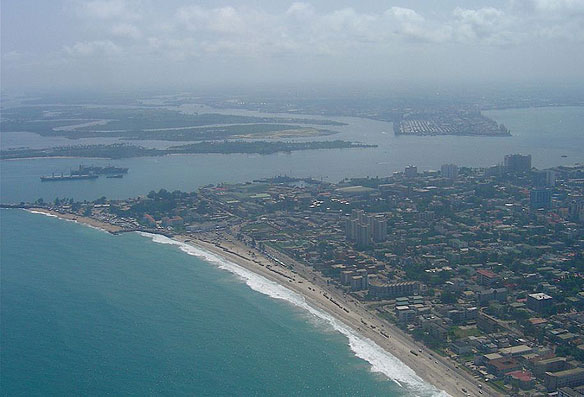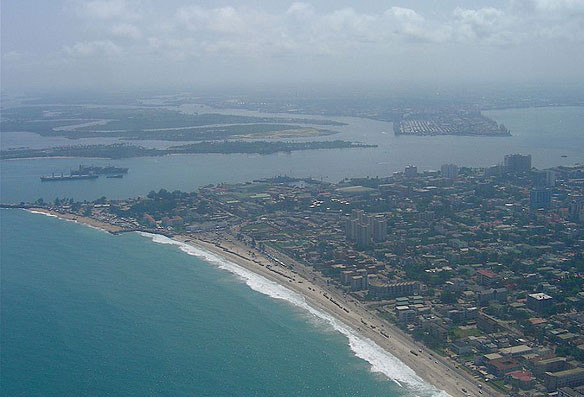
By Demola Abimboye
By 2016, Lagos will get a new city to be built on nine million square metres of reclaimed land about 2.4 kilometres into the Atlantic Ocean, south of Ahmadu Bello Way, Victoria Island. It promises to be Nigeria’s most ambitious city on reclaimed land and one of Africa’s biggest marine engineering projects.
Between now and 2016, about nine million square metres of land would be reclaimed 2.4 kilometres south of Ahmadu Bello Way, Victoria Island, Lagos, into the Atlantic Ocean.
The planned city is one and a half times the size of current Victoria Island. When completed, the new island would be called Eko Atlantic City. It is estimated to accommodate 250,000 residents and 150,000 commuters.
Already, 1.3 million square metres of prime land has been reclaimed. This has convinced many Nigerians of the viability of the project. Thus, many wealthy individuals and corporate bodies have bought plots of land ahead of completion schedule. The ambitious project is being undertaken by South Energyx Nigeria Limited, SENL, a subsidiary of the Chaghoury Group, which has been highly active in Nigeria for over 30 years. The group has handled many major construction and engineering works. SENL and the development of Eko Atlantic project were recognised by the Clinton Global Initiative in 2009 as committed to combating the threat of flooding to Victoria Island from rising sea levels.
For the success of Eko Atlantic City project, SENL boasts of partnership with some of the world’s experts in marine engineering, land reclamation and city design as well as strong financial backing. Royal Haskoning, a firm of Dutch architects and engineers, is involved while Dredging International, a Belgian company, is shouldering the massive landfill operation.
Four banks – three local and one international – are providing financial support for the entirely private sector project. These are First Bank PLC, Guaranty Trust Bank PLC, First City Monument Bank PLC and BNP Paribas Fortis of France. Diya, Fatimilehin & Co, a firm of estate surveyors and valuers, is marketing the gigantic prime real estate business.
Marc Chaghouri of SENL told Newswatch that the concept is to create an international standard city. The city will cover seven districts: Ocean Front, Harbour Lights, Business District, Eko Drive, Marina, Avenues and Downtown.
The business district will be spread across 1.3 million square metres dedicated to providing West Africa with a world class commercial hub. At the heart of this district will be the Eko Atlantic financial centre, “a key to success and prosperity.” The centre’s imposing towers will house corporate headquarters-banks, insurance companies, a room for stock exchange and hotels. “It will open a new vista for Nigeria and Africa,” Chaghouri said, adding: “The city will provide world class property in a world class environment where people can live and work in harmony.”
The city’s planners have incorporated round the clock independent power generation, central water supply and sewage disposal systems into the scheme. With a global certificate of occupancy already given by the Lagos State government, the developers have created a specialised planning unit to streamline an approval process and ensure quality of construction and integrity of each development.
There will be a light rail system with 60 stops throughout the city and canals for light ferry services. And aside a network of roads to ensure free traffic flow, every building must have basement parking spaces for its occupants and visitors. “Eko Atlantic City will have zero tolerance for street parking,” Chaghouri said.
To protect the new city against ocean surge, SENL is building a sea barrier which it fondly refers to as the Great Wall of Lagos. The 6.5 kilometre long wall was designed by Royal Haskoning and tested in Denmark by the world renowned Danish Hydraulic Institute, DHI. Chaghouri said the result proved that “it can withstand the worst storm imaginable in a thousand years.” The Great Wall is already one kilometre long when Newswatch visited last week.
Chaghouri said further that in building the wall, his company took cognisance of the chronic erosion of the Bar Beach which reached an unbearable peak in 2005 with severe threat of flooding. To check further erosion, a shoreline protection wall running along the entire length of the beach was built. Yet the ocean remained a threat to Victoria Island. It was against this backdrop that the idea of Eko Atlantic City emerged principally to restore the shoreline to where it was 100 years ago and build a world class city on reclaimed land.
Consequently, the Bola Tinubu administration granted SENL the concession to reclaim and develop land for the city in 2006. Since then, the company has recorded a huge success. Kolawole Diya of Diya, Fatimilehin & Co, marketing consultants to SENL on the prime real estate, said more that 1.3 million square metres of land is already visible and up for sale at between $825 and $1,600 per square metre.
He said it was denominated in dollar to protect buyers against fluctuations in the Naira exchange rate. He explained that since the rate is not static but changes regularly at the auctions by the Central Bank of Nigeria, buyers would be adequately protected against the vagaries in the financial supermarkets should the local currency depreciate sharply.
“We are proud of our currency but property transactions in commercial nerve centres of the world are being denominated in dollars. And Nigerian professionals have keyed in, more so, as thousands of foreigners and foreign companies are expected to own properties in Eko Atlantic City, Nigeria’s new gateway into Africa in the 21st century,” he said.
Victoria Island was originally surrounded by water, Atlantic Ocean in the south, the mouth of the Lagos Lagoon to the west, the five Cowrie Creek to the north and swamps on the east. The colonial government filled the eastern swamps to reduce mosquito breeding areas. This created a land bridge between the island and Lekki peninsula, thus ending its existence as a true island.
After independence, successive state governments expanded this development, culminating in the construction of a high way linking Victoria Island to Epe. VI, as it is popularly called, was initially intended for suburban residential development but became an attractive location for financial institutions and other businesses in the 1970s. The rapid expansion seriously outstretched limited amenities and resources. The developers of the new city hope to have independently reliable infrastructure to avoid the mistakes of the past without the government investing its scarce funds in it.
Shipwrecks and Vanishing Coastlines: a Nigerian Predicament, Coastal Care









